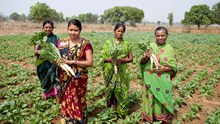
The mango is believed to have been first cultivated over 4,000 years ago in India. This tropical stone fruit grows on the Mangifera indica tree, which can tower up to 150 feet and live for centuries. Young mango trees bear red-orange leaves that gradually turn dark green as they mature. The fruits, which grow from small flowers, take about four to five months to ripen, transitioning from hard, green shells to soft, colorful delights.
Mangoes have played a significant role in India’s cultural and political landscape. Ancient texts and folklore refer to the mango tree as a symbol of prosperity and abundance. Gautam Buddha spent time meditating under mango trees at various points in his life, as per some sources. The Mughal emperors, known for their patronage of arts and culture, were also fond of mangoes. Emperor Babur was so impressed by the taste of Indian mangoes that it is believed to have strengthened his desire to conquer India. Later, under the Mughal rule, iconic mango varieties such as Chaunsa, Anwar Ratol, and Kesar were cultivated.
So precious was the mango that Emperor Bahadur Shah Zafar reportedly punished his own son for hoarding all the mangoes in the royal palace. As time passed, mangoes traveled beyond India to other parts of the world through trade and colonial expeditions. Traders and colonizers took mangoes to Portugal and Britain, and today, the fruit is enjoyed across continents. In fact, mangoes hold such cultural weight that they are recognized as the national fruit of India and Pakistan, and the national tree of Bangladesh. In South Asia, gifting a basket of mangoes is often seen as a warm and symbolic gesture of friendship.
Why Mango Day Matters
National Mango Day is not just about indulging in the sweet and tangy flavors of the fruit. It is also about appreciating the cultural, historical, and economic significance of the mango. The fruit is an integral part of several cuisines, traditions, and even diplomacy in South Asia. For centuries, mangoes have been served during important festivals, weddings, and royal feasts.
From a nutritional standpoint, mangoes are a powerhouse of vitamins such as A, C, and E, along with antioxidants, minerals, and dietary fiber. These qualities make them excellent for skin health, immunity, digestion, and overall wellness. Moreover, mangoes are among the most widely grown fruits in India and contribute significantly to the country’s agricultural economy.
Popular Indian Mango Varieties
India, often regarded as the home of mangoes, is blessed with more than 1,000 varieties, each with its own unique flavor, aroma, and story. Here are some of the most popular ones you must try:
-
Alphonso (Hapus)
Known as the “King of Mangoes,” Alphonso is grown mainly in Maharashtra’s Konkan region. It is famous for its rich sweetness, non-fibrous golden flesh, and aromatic taste. Ideal for desserts, smoothies, and simply eating fresh.
-
Kesar
Grown in Gujarat, Kesar mangoes are often called the 'Queen of Mangoes.' They have a bright saffron-colored pulp with a smooth, fragrant flavor that pairs beautifully with Indian sweets like shrikhand.
-
Dasheri
Native to Malihabad in Uttar Pradesh, Dasheri mangoes are juicy, sweet, and perfect for making mango shakes or aamras. They have a thin peel and a distinctive aroma that brings instant nostalgia.
-
Langra
Popular in Uttar Pradesh and Bihar, Langra mangoes are green even when ripe. They have a sweet and tangy pulp that is often used in traditional chutneys or enjoyed fresh.
-
Totapuri
Grown in southern states like Andhra Pradesh and Karnataka, Totapuri has a beak-like tip, hence its name. It has a mildly sour taste and is commonly used in pickles, salads, and juices.
-
Chaunsa
Originally from Pakistan but also grown in India, Chaunsa is highly aromatic and extremely sweet. It is soft, creamy, and often enjoyed by squeezing the mango and sipping its juice straight from the skin.
-
Himsagar
This is a prized mango from West Bengal and Bangladesh, known for its smooth, fiberless texture and excellent sweetness. It is typically available for only a short season in early summer.
-
Amrapali
A hybrid between Dasheri and Neelum, Amrapali is grown across India and is known for its deep orange flesh and compact tree size. Its rich flavor makes it popular for both home consumption and juice processing.
How to Celebrate National Mango Day 2025
Whether you are a lifelong mango lover or new to this juicy obsession, there are many exciting ways to celebrate National Mango Day.
-
Host a Mango Tasting Party
Invite friends and family to sample a variety of mangoes. Serve slices of Alphonso, Kesar, Dasheri, and Chaunsa, and let guests vote for their favorite. Add a fun quiz about mango facts to make it interactive.
-
Try a New Mango Recipe
Experiment with traditional Indian dishes like aam panna, mango lassi, mango kulfi, or green mango chutney. You can also try global recipes like mango salsa, mango cheesecake, or grilled mango skewers.
-
Visit a Local Mango Orchard
If you live near a mango-growing region, plan a visit to a local farm. Many orchards offer mango picking tours during the peak season, giving you a firsthand experience of where your favorite fruit comes from.
-
Support Local Farmers
Buy mangoes from local markets or participate in mango festivals and exhibitions. Many events showcase organic or heritage mangoes while supporting small-scale farmers and indigenous growers.
National Mango Day is a delightful occasion that reminds us of the simple pleasures of life. Mangoes are more than just a summer fruit, they are a celebration of tradition, family, and the vibrant flavors of nature. As July 22 approaches, take the time to enjoy a ripe mango, learn about its roots, and share the love with those around you. Whether you are biting into a juicy Alphonso or sipping on a chilled mango lassi, remember that you are partaking in a history that spans thousands of years and countless cultures.















